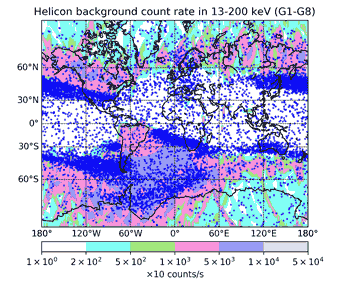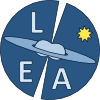The CORONAS-F space solar Observatory was designed to study the Sun at different phases of the 11-year solar cycle. On July 31, 2001, the Observatory was launched to the near-Earth orbit with the following parameters: the inclination of the orbit was 82.49°, the minimum distance from the Earth was 500.9 km, the maximum distance constituted 548.5 km, the period of rotation was 94.589 minutes. The precession rate of the orbit was 1.01° / day. The device was stabilized by rotation relative to the axis pointed at the Sun. The accuracy of orientation was under 10'.
Instrument description
The Helicon hard X-ray and soft gamma-ray spectrometer was designed to register solar flares in the energy range of 10 keV – 10 MeV, in addition to cosmic gamma-ray bursts, bursts from soft gamma-ray repeaters and other transient gamma-ray sources. The spectrometer consisted of two identical gamma-ray detectors located on two opposite sides of the satellite, the axes of the detectors coincide with the axis of satellite rotation, the first detector observed the solar hemisphere, and the second observed the anti-solar hemisphere. The detectors were similar to those of the Konus-Wind experiment. Each detector presented NaI(Tl) crystal 13 cm high and 7.5 cm in diameter.
The instrument operated in two modes – in the waiting and in the triggered modes. In the waiting mode, the count rate was continuously measured in 8 energy channels (G1 – G8) with temporal resolution of 1024 ms. The nominal channel boundaries were: 13-19 keV (G1), 19-25 keV (G2), 25-34 keV (G3), 34-47 keV (G4), 47-62 keV (G5), 62-87 keV (G6), 87-141 keV (G7), 141-191 keV (G8). In addition, 256-channel spectra were measured in the energy range of 215 keV – 9.8 MeV with accumulation time of 32 s.
In the triggered mode, time history was recorded in three high-resolution energy bands. The energy boundaries were: 10-50 keV(G1), 50-250 keV(G2), 250-750 keV (G3). The structure of the time history record was as follows:
- 512 time bins with resolution of 2 ms (from -0.512 s to 0.512 s from trigger time)
- 2048 time bins with resolution of 16 ms (from 0.512 s to 33.280 s from trigger time)
- 1024 time bins with resolution of 64 ms (from 33.280 s to 98.816 s from trigger time)
- 512 time bins with resolution of 256 ms (from 98.816 s to 229.888 s from trigger time)
Also multichannel spectra were measured in two overlapping ranges, first range 13 keV - 700 keV and the second range 200 keV – 8 MeV. Each range consisted of 64 channels, and the spectrum accumulation time varied from 64 ms to 8 s.



